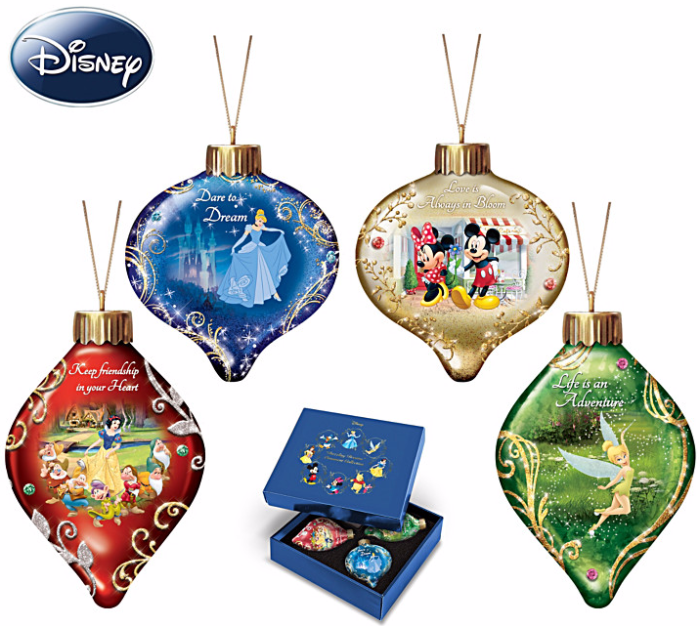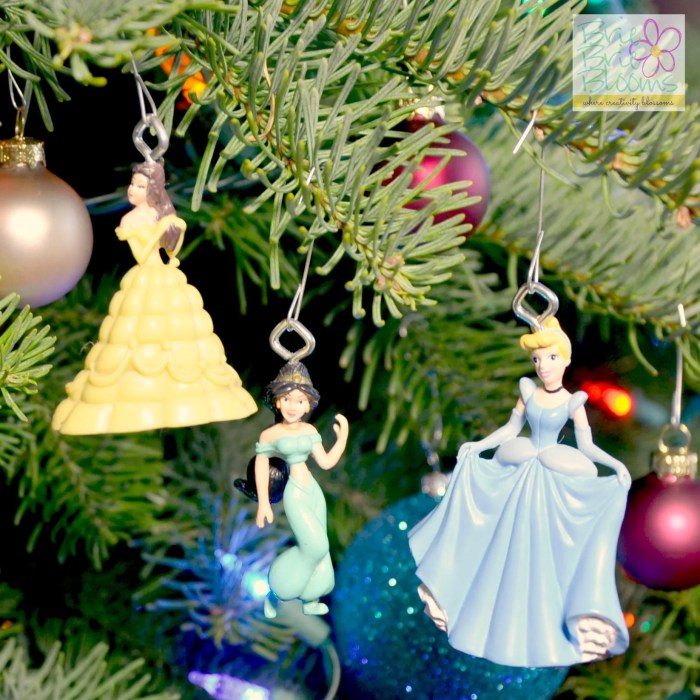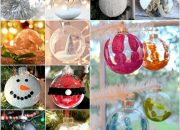Design and Aesthetics of Disney Ornaments

Disney ornament christmas tree – The shimmering allure of Disney Christmas ornaments has captivated collectors for decades, transforming simple tree decorations into miniature works of art. Their evolution reflects not only changing design trends but also the ever-expanding Disney universe itself, incorporating beloved characters, iconic scenes, and innovative techniques. The journey from simple, two-dimensional figures to intricately detailed, three-dimensional masterpieces reveals a fascinating story of artistic innovation and commercial success.The evolution of Disney ornament designs over the past 20 years showcases a clear progression towards greater complexity and detail.
Early 2000s ornaments often featured simpler designs, relying heavily on flat, painted surfaces and basic shapes. However, more recent designs incorporate intricate sculpting, metallic finishes, and even light-up elements, creating highly collectible and visually stunning pieces. This shift reflects advancements in manufacturing techniques and a growing demand for more sophisticated and detailed ornaments.
Unique and Innovative Disney Ornament Designs, Disney ornament christmas tree
Several ornaments stand out for their unique and innovative designs. For instance, the “Haunted Mansion” ornament series features intricately detailed miniature versions of the ride’s iconic scenes, complete with tiny ghosts and spectral effects. These are not simply painted figures; they are small-scale recreations, often incorporating multiple layers and textures to achieve a realistic effect. Another example is the series of ornaments featuring characters from Disney’s animated shorts, demonstrating a focus on less-known but equally beloved characters, adding depth and variety to the collection.
These showcase a remarkable level of detail, even capturing the subtle nuances of animation style. These ornaments represent a departure from solely focusing on flagship characters, offering a more niche appeal to collectors.
The saccharine charm of Disney ornament Christmas trees, with their meticulously crafted figurines, often evokes a nostalgic sentimentality. This contrasts sharply, yet intriguingly, with the delicate elegance found in a more understated aesthetic, such as the floral motifs presented by a rose Christmas tree ornament. Ultimately, both styles contribute to the multifaceted tapestry of Christmas decoration, each offering a distinct narrative within the larger festive display.
The Disney ornaments, however, often retain a dominant position due to their powerful cultural association.
Comparative Design Styles Across Disney Properties
Disney ornaments reflect the distinct artistic styles of their various properties. Pixar ornaments, for example, often feature a more stylized, almost cartoonish aesthetic, emphasizing bold colors and simplified shapes. This reflects the characteristic design language of Pixar animation. In contrast, Marvel ornaments often incorporate a more realistic or semi-realistic style, with detailed musculature and textures on character figures. This aligns with the more grounded visual style of the Marvel Cinematic Universe.
Star Wars ornaments tend to capture the epic scale and futuristic designs of the franchise, often featuring metallic finishes, intricate detailing, and occasionally incorporating light-up elements to evoke the feel of spaceships and lightsabers. This demonstrates a clear understanding of each franchise’s distinct visual identity and its translation into the three-dimensional format of Christmas ornaments.
Color Palettes and Artistic Styles
The use of color palettes and artistic styles in Disney Christmas ornaments is a key element in their appeal. Early ornaments often employed a limited palette, emphasizing primary colors and simple shading. However, more recent designs showcase a broader range of colors and techniques, from realistic shading and highlighting to the use of metallic paints and glitter to enhance the visual impact.
The artistic styles range from traditional hand-painted designs to more modern techniques, such as digital printing and 3D modeling, enabling the creation of highly detailed and complex ornaments. The transition reflects a progression from simple, mass-produced designs to more sophisticated, collectible items. For example, the shift towards utilizing more metallic finishes, particularly in the Star Wars line, perfectly complements the franchise’s futuristic aesthetic, creating a strong visual connection.
Manufacturing and Production of Disney Ornaments

The hushed halls of the Disney ornament factory hold secrets whispered on the wind – secrets of shimmering glass, meticulously painted details, and the magic that transforms simple materials into cherished keepsakes. The process, while seemingly straightforward, is a complex ballet of artistry, engineering, and a surprising amount of environmental consideration. Each ornament, a tiny piece of a larger narrative, begins its journey with a spark of creative vision and ends nestled within a festive package, ready to adorn a Christmas tree.The creation of these miniature works of art involves a multifaceted process, starting long before the first piece of glass is molded.
Designers meticulously craft the initial concepts, translating beloved characters and scenes into three-dimensional forms. This initial phase dictates the materials, production methods, and ultimately, the environmental footprint of the final product.
Materials Used in Disney Ornament Creation
A variety of materials contribute to the diverse range of Disney ornaments. Glass remains a mainstay, offering a smooth surface ideal for intricate detailing and a classic, elegant aesthetic. Many ornaments incorporate resin, a versatile material allowing for complex shapes and vibrant colors. Metals, such as pewter or aluminum, add weight and a sense of permanence to certain designs, often used for accents or character figurines.
Finally, various paints, glitters, and other embellishments are employed to bring the designs to life, each adding a unique textural element. The selection of these materials is a careful balancing act, considering both aesthetic appeal and production feasibility.
The Manufacturing Process: From Design to Packaging
The journey of a Disney ornament begins with a digital design, often refined through multiple iterations before reaching the production stage. For glass ornaments, molten glass is carefully shaped using molds, a process requiring precise temperature control and skilled craftsmanship. Resin ornaments may utilize injection molding, a faster, higher-volume production method. Once the base ornament is formed, the detailed painting and embellishment process commences.
This often involves skilled artisans applying multiple layers of paint, meticulously adding fine details and ensuring consistent quality. After quality control checks, ornaments are carefully packaged, often in protective boxes to prevent damage during shipping and storage. The entire process, from initial design to final packaging, is a testament to meticulous planning and execution.
Sustainability Practices in Disney Ornament Production
Disney has made strides towards more sustainable manufacturing practices. This includes sourcing materials from responsibly managed forests for packaging, exploring the use of recycled materials in ornament production, and implementing energy-efficient manufacturing processes. The company actively seeks to reduce waste by optimizing production methods and recycling materials whenever possible. While complete elimination of environmental impact is a near-impossible goal, Disney’s commitment to sustainability is evident in its ongoing efforts to minimize its ecological footprint.
Potential Environmental Impacts and Mitigation Strategies
The production of Disney ornaments, like any manufacturing process, presents potential environmental challenges.
- Energy Consumption: The manufacturing process, particularly glass melting and resin molding, requires significant energy input. Mitigation: Investing in renewable energy sources and implementing energy-efficient technologies.
- Material Sourcing: The extraction and processing of raw materials, such as glass and metals, can have environmental impacts. Mitigation: Sourcing materials from responsible suppliers committed to sustainable practices and minimizing waste.
- Waste Generation: Production processes generate waste, including broken ornaments, excess materials, and packaging. Mitigation: Implementing waste reduction strategies, recycling programs, and exploring biodegradable packaging options.
- Emissions: The manufacturing process can release greenhouse gases and other pollutants into the atmosphere. Mitigation: Implementing cleaner production technologies, reducing emissions through process optimization, and investing in carbon offset programs.
- Water Usage: Certain manufacturing stages, such as cleaning and painting, require water. Mitigation: Implementing water-saving technologies and recycling wastewater wherever feasible.
Visual Representation of Popular Disney Ornaments: Disney Ornament Christmas Tree

The shimmering allure of Disney Christmas ornaments transcends mere decoration; they are tangible pieces of nostalgia, encapsulating cherished memories and beloved characters. Their visual representation, encompassing design, materials, and overall aesthetic, speaks volumes about Disney’s enduring legacy and the artistry involved in their creation. The following details explore the visual characteristics of some particularly popular ornaments, offering a glimpse into their captivating world.
Three Highly Popular Disney Christmas Ornaments
Three ornaments consistently stand out for their popularity: Mickey Mouse in his classic red shorts, a detailed Cinderella Castle, and a whimsical rendition of Olaf fromFrozen*. The Mickey Mouse ornament often features a traditional design, typically crafted from resin or glass, depicting Mickey in a festive pose, perhaps holding a candy cane or wearing a Santa hat. Its size is usually modest, around 3-4 inches tall, making it perfect for smaller trees or as a standalone piece.
Packaging is generally simple, a clear plastic box showcasing the ornament. Special features might include glitter detailing or a subtle metallic finish. The Cinderella Castle ornament, on the other hand, boasts intricate detailing, capturing the grandeur of the iconic landmark. Often made from resin or a combination of materials, it’s larger, perhaps 5-6 inches tall, and commands attention on any tree.
Its packaging is usually more elaborate, reflecting the ornament’s premium feel. Special features might include LED lighting or hand-painted accents. Finally, the Olaf ornament, representing a more modern Disney aesthetic, is often characterized by its playful design and softer materials, perhaps plush or fabric, lending it a cuddly quality. It’s usually smaller than the castle, perhaps 3 inches tall, and its packaging reflects its fun-loving nature.
Special features might include embroidered details or a unique texture.
Visual Appeal of Classic versus Modern Disney Ornaments
A classic Disney ornament, like a vintage Mickey Mouse or a simple rendition of a Disney princess, typically employs a minimalist design. The focus is on clean lines, bold colors, and a nostalgic charm. Materials are often traditional, such as glass or ceramic, and the overall aesthetic evokes a sense of timeless elegance. In contrast, a modern Disney ornament often incorporates more intricate detailing, mixed media, and a broader range of materials, reflecting contemporary design trends.
Think of the complex layering of a
Frozen* themed ornament or the use of innovative materials like felt or acrylic in newer designs. Despite these differences, both classic and modern ornaments share a common thread
the evocation of beloved Disney characters and stories. Both aim to capture the magic of Disney, albeit through different stylistic approaches.
Mass-Produced versus Handcrafted, Limited-Edition Disney Ornaments
A mass-produced Disney ornament is typically made from resin or plastic using a molding process. It’s designed for affordability and wide distribution, resulting in a consistent look and feel across many pieces. The detail level is often moderate, focusing on recognizable features of the character or scene depicted. Packaging is usually simple and functional. In stark contrast, a handcrafted, limited-edition Disney ornament is a unique piece, often made from higher-quality materials like glass, porcelain, or even precious metals.
The level of detail is significantly higher, with hand-painted features, intricate embellishments, and a distinct artistic style. These ornaments are individually crafted, making each one slightly different and thus highly collectible. Packaging is usually luxurious and protective, reflecting the ornament’s value and rarity. The limited edition nature further adds to its desirability and perceived value. Imagine a hand-blown glass Snow White ornament, each one subtly unique in its glass texture and painted details, versus a mass-produced plastic version.
The difference is immediately apparent in both quality and aesthetic.
Frequently Asked Questions
Where can I find authentic Disney ornaments?
Authentic Disney ornaments are typically found at Disney Stores, Disney Parks, select retailers like Target and Walmart, and online marketplaces like Amazon and eBay (be mindful of counterfeit products on online marketplaces).
How do I care for my Disney Christmas ornaments?
Handle ornaments gently to avoid breakage. Dust them with a soft cloth or feather duster. For more thorough cleaning, use a damp cloth (avoid excessive moisture) and allow them to air dry completely before storing.
Are Disney ornaments suitable for outdoor use?
Most Disney ornaments are intended for indoor use only. Exposure to harsh weather conditions can damage the materials and diminish their beauty.
How can I tell if a Disney ornament is a limited edition?
Limited edition Disney ornaments often have special markings on the packaging or the ornament itself, indicating the limited edition number or year. Check for certifications or unique details that differentiate them from regular production ornaments.








